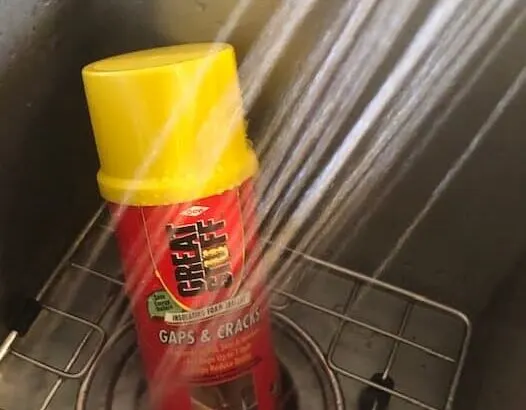I was working on air sealing the exterior of my home where I had a hole around the air conditioning pipes that was too large to seal with silicone. I wondered if I could apply Great Stuff foam in an area that is exposed to rain and moisture. I researched this and here’s what I found.
Is Great Stuff Waterproof? Dupont now offers a Great Stuff version called Pond and Stone spray that is intended for use in direct contact with water. They also now offer a special Black Insulating foam sealant that is intended for both indoor and outdoor use. It’s important to understand the differences between the various products when it comes to using expanding foam around wet areas.
I wanted to get a clearer understanding of what the Pond and Stone product’s water-resistant abilities and limitations were as well as to fully understand how these outdoor versions of Dupont’s Great Stuff products were intended to be used. I did quite a bit of research and even reached out to Dupont for an official answer. Here’s everything I’ve learned.
Different Expanding Foams For Different Uses
Just as you need to have the right tool for the right job, it’s important to have the right expanding foam for the right project. Dupont offers a variety of Great Stuff Expanding Foam options for a wide array of needs and uses.
I have used Great Stuff products in my home, rehabs, and rental projects for years. It is an excellent way to seal air leaks and close huge gaps that allow pests into the home. To see examples of how Great Stuff expanding foam can be used to air seal your home, read Is My Home Energy Efficient? Here’s How To Know!
But when it comes to using Great Stuff in direct contact with water, it’s important to use the right version of this product.
Great Stuff Pond and Stone
Great Stuff Pond and Stone is specifically designed to be used in wet areas including around outdoor fixtures and direct water flow such as an outdoor rock waterfall. It is also suitable for any location where an expanding foam is needed but a black foam color is preferred. This is all explained in Dupont’s information brochure available at this link.

Dupont claims that the new Great Stuff Pond and Stone foam is very durable in wet locations and will last for years. They even report that it can be applied to both dry and damp surfaces.
Depending on your use case, this may be the perfect solution. You do not have to worry about the foam coming into frequent, direct contact with water.
The foam is black and intended to blend in with its surroundings when used around ponds or as an adhesive for stones such as in a retaining wall. It cures in around 8 hours so it is meant to be applied and then left to cure and dry.
Because it is designed to come into direct contact with flowing water, the Pond and Stone product offers opportunities to seal cracks and holes in wet locations where previous products were not intended or recommended.
It is notable that in the company’s product literature, they are promoting that the product is reusable for up to 30 days. That definitely increases your ability to prevent waste and make the most of this product.
I used Great Stuff foam to seal a couple of joints when I installed a French drain system. Had I known that this product existed, I would have used it instead since it is specifically intended for use in wet areas.
Great Stuff Black Insulating Sealant

This version of Great Stuff expanding foam also offers water resistance. It is not meant to be in constant direct contact with water but is suitable for outside locations where exposure to water is likely.
Examples include sealing around external piping and faucets, basement areas, and electrical and cable lines. It is fine for indoors too, making it one or the more versatile versions of the Great Stuff brand. In fact, the manufacturer refers to it as the “jack of all trades” of their expanding foam product line. It is intended for gaps up to one inch.
But the traditional Great Stuff Gaps and Cracks version is also labeled as suitable for inside and out so the real difference between these two actually seems to be the coloring of the foam. Dupont promotes Great Stuff Black Insulating Sealant as being able to blend into its surrounding environment. Considering the fact that Great Stuff foam sprays are paintable and stainable, I’m not sure as to how beneficial this is.
The company does not yet have information videos on the Pond and Stone foam spray but the below video on using the Great Stuff Black Insulating Foam Sealant will likely provide insightful guidelines on proper preparation and application that will be suitable for the Pond and Stone version as well.
Great Stuff Expanding Foam Waterproofing Alternatives
There are several alternatives when looking for a foam sealant that is intended for wet areas. Most are marketed as waterfall sealants. As a result, they are advertised as safe for fish. Dupont’s version holds true to this claim as well.
When considering alternatives for waterproofing with expanding foam, it’s important to understand a manufacturer’s intended use for a product. Which leads us to…
Water Resistant verses Water Proof
It is interesting to note that these products are consistently advertised as water “resistant” rather than waterproof. I suspect this is to reduce liability related to the product being used in a way that it is not intended such as fully submerged 24 hours per day.
It is not a pool sealant, after all. But as far as it’s durability when coming into direct contact with flowing water, expanding foams like Great Stuff Pond and Stone are designed to meet the demands of wet locations.
It is worth noting that if you go to the Dow website (Dow and Dupont merged in 2017) you can search for products using keywords. If you search for “Weather Resistant”, several of the Great Stuff product offerings show up, including Pond and Stone.
If, however, if you search for “waterproof”, the company’s website will return no results for Great Stuff products. I think that pretty much settles their position on
Just to be sure, I contacted the manufacturer and received a response that states the following:
GREAT STUFF™ Pond & Stone is a water resistant closed cell foam that will likely hold up being submerged for short periods of time but degradation could occur if submerged for long periods of time as GREAT STUFF™ products will chemically bond to just about all surfaces in a matter of minutes and once cured, it cannot be removed with solvents and the only option is mechanical removal. ***Email Response from Dow***
Recommended Waterproofing Sealant Options
There are various options for waterproofing or water-resisting sealants depending on what you are needing to do.

For sealing small cracks, plain old silicone works great. If the holes are larger and expanding foam is needed, a product like Great Stuff Pond and Stone may be just the thing.
But if you have a large surface area that you are needing to seal, you may be looking for something more like Liquid Rubber. It comes in a one gallon can like a paint can and adheres to wood, metal, and concrete. It’s used for sealing / repairing roofs and various other big projects.
Finally, don’t overlook the relatively new “as seen on TV” Flex Seal. Available in a spray can and in various color options, this stuff has turned out to be pretty reliable when applied according to directions.
I actually used it to seal areas on my roof where nails were protruding through the shingles. I dismissed Flex Seal for a long time as overhyped but I have to say, I’ve come around.
The point is, you have options. You want to select the right water sealing product for your use case.
Is Great Stuff Dangerous?
Just as any compressed chemical product, Great Stuff foam should be used strictly in accordance with manufacturer’s guidelines. See the company’s Consumer Safety Information for hazards.
One important note about safety – Great Stuff foam contains isocyanate. According to the Environmental Protection Agency, Isocyanate may cause irritation to skin, eyes, and lungs as well as other health concerns. I would encourage you to read the full report, Health Concerns about Spray Polyurethane Foam.
I don’t tell you this to scare you, only to ensure that you are informed of the potential health concerns when working with expanding foams. The point here is, follow the manufacturer’s precautions and directions for use. I have used expanding foams such as Great Stuff many times through the years and have found it to be extremely effective at sealing large air leaks.
Conclusion
The key to all of this is picking the right weapon for the battle. If you dealing with very small cracks that are often submerged in water, I would recommend you stick with silicone. If you have a large surface area to waterseal, a product like Liquid Rubber or Flex Seal will likely be your best bet.
But, if your project falls somewhere in between, with larger cracks or holes to cover but the likelihood of at least occasional to frequent exposure to water, a product like Great Stuff Pond and Stone may be just what you need.
To gain an overall understanding of the intended uses of each of Dupont’s Great Stuff product offerings, read
Where, When, and Which Great Stuff Foam Sealant To Use.
Note: I have attempted to provide as accurate of information as possible based on my research. Ultimately, I recommend reviewing product and consumer safety information from the manufacturer to ensure that you are fully informed. I have provided links to referenced documentation within this article.
As a homeowner, I am constantly experimenting with making the structure of my house more energy-efficient, eliminating pests, and taking on DIY home improvement projects. Over the past two decades, my family has rehabbed houses and contracted new home builds and I’ve learned a lot along the way. I share my hard-learned lessons so that you can save time and money by not repeating my mistakes.


Leave a comment
You must be logged in to post a comment.